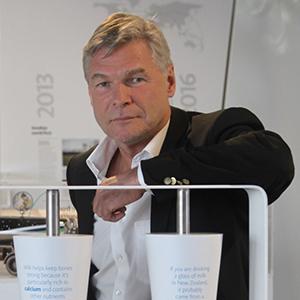CIO100 2018 #31-100: Gerben Otter, Fonterra

“Two large areas of focus for Fonterra are simplifying/standardising processes and removing complexity,” says Gerben Otter, the company’s global CIO.
“Across the globe, there are numerous ERP systems in place that run different versions of different installations of software. One of Global IS’ strategic goals is to reduce these ERP systems to two major SAP instances that represent Fonterra’s main business model. This is known as the Dual Core strategy.
In August, 2017, the first ‘fold-in’ (as opposed to rollout) was successfully completed, bringing the Sri Lankan business online with the same major SAP instance as Australia. The project was a success and the programme is building on this success to fold more Asian markets into the Dual Core strategy he says.
“A large part of the success of the Sri Lanka fold-in was the ownership of the change by the business. The GIS team and the Sri Lankan business team worked closely from day one, understanding how the business would need to change their processes to adopt the global standard.
“Only small deviations from the standard were made for local legislative or regulatory requirements. This allowed the technical teams to get on with the task of building interfaces, testing and implementation.”
Within Fonterra, he says, there is a dedicated innovation incubator that investigates ideas, creates concepts and develops these concepts to minimum viable products. This is a collaborative effort across all areas of the business with strong Global IS involvement.
He says some of the ideas being investigated are in precision agriculture, blockchain and 3D printing.
“Recently, one of the initiatives has graduated from the incubator to production – robotics and process automation. More are expected to move to production this year,” he says.
While some innovations may not be unique to the world of technology, they will be unique to agriculture, with Fonterra leading the way, says Otter.
“Using all the data that we can harvest from farms to manufacturing, across the entire supply chain and to the consumer provides valuable insights into realizing Fonterra’s vision of making a difference the lives of two billion people by 2025.”
“The innovation team provides a platform to enable this.”
Using IoT sensors and devices to gather data and turn this into meaningful knowledge using advanced analytics will give Fonterra the edge from grass to glass, he adds.
In addition, Fonterra needs to ensure that the factories are kept in peak condition. Predictive plant maintenance and workforce mobility make sure everything stays tip top, he says.
Leading through change
“While we haven’t yet experienced negative sentiment by introducing tech, we anticipate normal teething problems,” he says, on the impact of some of these technologies to the global team.
“We plan to solve this through careful and deliberate organisational change management, so that the opportunities that new technologies bring can be realised as quickly as possible.”
The Global IS team conducts regular interactions directly with the Fonterra Management Team (FMT).
At least once a quarter, updates on the GIS strategy, known as ‘Direction of Travel’ are discussed with the FMT leaders.
Contained within this are large strategic projects and initiatives, which are directly sponsored by members of the FMT and are defined in ‘six monthly buckets’, focusing on achievable, deliverable business outcomes, says Otter.
Fonterra Global IS spans more than 15 countries across four regions: Australia/New Zealand; Asia/Middle East; Greater China and Latin America. The nuances that stem from delivering global projects across these regions requires leadership across a culturally diverse environment.
“Additionally, opportunities are provided within IS and across the business to develop leadership growth from within. Rotation is encouraged between the teams, functions and sometimes even between regions,” says Otter.
MilkyWay is Fonterra’s intranet portal for all of its staff across the world. It provides everything employees need from HR information to social groups and collaborative workspaces. A programme has recently been completed (MilkyWay 2.0) that puts this information into the palm of everyone’s hand with the MilkyWay app.
For Otter, one of the main challenges for every CIO is to create and maintain business ownership for IS initiatives.
“We showed with the Sri Lanka implementation and already with phase 2 of that programme how important that is and that we are able to maintain that momentum in the organisation on an international scale.
“Managing directors and other business people are leading by example, walking the talk and demonstrating the importance of this success.”